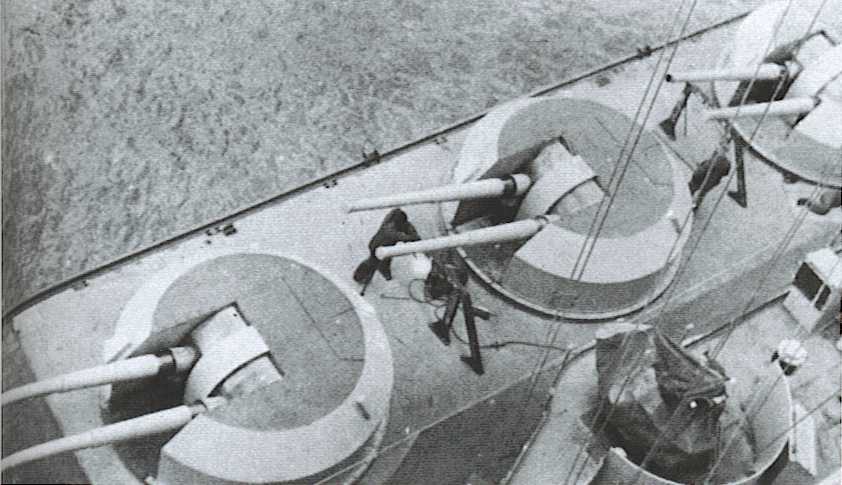
These weapons were originally designed to arm the new carriers being built in the 1930s. They were also used on auxiliary vessels and to rearm a few capital ships and then late in the war they became the standard weapon for fleet destroyers.
The Mark I and Mark III guns were used only in twin mountings and were interchangeable with each other, the only difference being in details of the firing mechanism. Several ships actually carried both gun types, depending upon what was available when the ships were being built or modernized. The Mark IV was ballistically identical to the Mark I and Mark III guns but slightly modified in order to fit on the standard 4.7" (12 cm) CP XXII single mountings used on destroyers and to use separate ammunition. The Mark II was an Army AAA weapon, generally similar to the naval guns but not mounted afloat.
Following the failure of the 5.1"/50 (13 cm) QF Mark I program, the 4.5" (11.4 cm) caliber was selected in the middle 1930s as the new DP weapon for carriers. It was believed that this was the largest caliber that could be used for a manually-handled fixed round and the complete round for this weapon weighed 85 lbs. (38.6 kg) versus 108 lbs. (49 kg) for the 5.1" (13 cm) gun. However, even though this was a lighter round than that for the 5.1" (13 cm) gun, this decision on the basis of weight was contradictory for two reasons. First, the slightly lighter 4.7" (12 cm) ammunition for destroyers had always been made in separate form in order to reduce the task of the ammunition handlers. Secondly, a fixed round had been designed in the 1920s for the 4.7"/40 (12 cm) Mark XII anti-aircraft guns used on the Nelson class battleships and this round weighed 74 lbs. (33.6 kg) complete. During service evaluations of the 4.7" (12 cm) Mark XII, it was found that it could not maintain a high rate of fire - a necessity for an AA weapon - as the heavy fixed round rapidly wore out the gun crews. So, if by the early 1930s, it was being found that a 74 lbs. (33.6 kg) fixed round was too heavy to allow sustained rapid firing, then it seems odd that a few years later that an 85 lbs. (38.6 kg) fixed round was deemed to be acceptable. It would appear that the active Navy and the Admiralty had a considerable lack of communications regarding practical experience with fixed ammunition. Not surprisingly, this fixed round proved to be too heavy in service use and there was a tendency for the projectiles to separate from the cartridge cases during normal handling. These problems resulted in a rapidly decreasing rate of fire during prolonged firing periods.
Learning from war-experience and unlike all previous capital ship twin mountings, the Mark II*** BD twin mountings designed and built for the post-war carriers Ark Royal and Eagle were modified versions which used separate ammunition.
On 8 May 1941 while HMS Renown was engaging Italian torpedo bombers, a fail-safe lockout system malfunctioned and her P3 mounting fired into the back of P2 mounting, killing six and wounding twenty-six crewmembers. Angle iron frameworks were erected by the ship's crew around the mountings to prevent a repeat episode. The fail-safe gear was overhauled during a refit at Rosyth later that same year.
In 1944, guns of 4.7" (12 cm) caliber, which had been used on nearly every British destroyer built since 1918, gave way to a new destroyer weapon, the 4.5" (11.4 cm) QF Mark IV gun which was employed in both single and twin mountings. It had originally been planned that destroyers would also use fixed ammunition, but reports from the cruisers Scylla and Charybdis told of loading problems during rough weather due to the heavy weight of the ammunition. As these were 6,000 ton (6,100 mt) cruisers, it was an obvious conclusion that the much lighter destroyers would have even worse handling problems - a conclusion that the Royal Navy should have been aware of for over a decade. To alleviate the problem, these new destroyer mountings were designed to use separate ammunition. Compared to the standard 4.7" (12 cm) Mark IX, the new destroyer guns had a higher rate of fire and used a heavier projectile with better ballistic properties, but it is questionable whether these advantages outweighed the disadvantage of adding yet another mid-caliber weapon and its specialized munitions to the already overloaded British logistical system. It did have a post-war advantage in that this new caliber became the standard size for Royal Navy destroyers and continues in use to the present day.
It would appear that any of these 4.5" (114 mm) guns could fire fixed or separate ammunition, the differences were in the ammunition supply arrangements of the mountings.
Nomenclature note: In the 1950s the British weapon designation system changed from being per the gun itself to being per the mounting. At the same time, arabic numerals replaced roman numerals. Some confusion was created under this new system because older weapons were redesignated, even though the weapons and mountings themselves did not change. Under this new system, the 4.5-in (11.4 cm) Mark I, Mark III and Mark IV guns in the Mark II, Mark III, Mark IV and Mark V mountings were redesignated as Mark 2 and Mark 3 for the twin mounts used on carriers and as Mark 4 (twin) and Mark 5 (single) for the mounts used on destroyers. Asterisks used in the old designation system to denote changes were carried forwards to the new system, but new changes were given "Mod" numbers. This meant that the Royal Navy now had designations such as 4.5-in Mark 5* Mod 2 which meant that this particular mounting had gone through three modifications since it was first designed. As could be expected, these changes have led to much confusion as to what weapons were actually used on any particular ship. For this reason, at the top of this datapage, I show both the original per-the-gun designation and, in parenthesis, the per-the-mounting redesignations.
Gun construction was of an autofretted loose barrel, jacket, removable breech ring and sealing collar. The breech mechanism used a horizontal sliding breech block. Guns could be operated in either Quick Firing (QF) or Semi-Automatic (SA) mode. In QF mode, the breech was manually opened after firing by moving a lever which also ejected the spent casing. In SA mode, the breech would open automatically after firing and eject the spent casing. During loading, the breech mechanism would partially close when the cartridge case rim hit the ejectors and then fully close when the loading tray was raised. Mark I had both percussion and electric firing while the Mark III was designed for all-electric firing. The Mark I was later modified to permit electric only firing. The Mark IV used electric firing and the breech mechanism was considerably lighter with more generous radii on some components. Five experimental, 46 Mark I, 524 Mark III and at least 199 Mark IV guns were manufactured. Guns needed to be dismounted in order to change the barrels. It should be noted that these weapons had a relatively short barrel life.
All British 4.5" naval guns have an actual bore diameter of 4.45" (11.3 cm).
| Designation | 4.5"/45 (11.4 cm) QF Marks I, III and IV |
|---|---|
| Ship Class Used On | Mark I
Ark Royal (1937), Forth, Maidstone and Illustrious class Queen Elizabeth (3 guns), Valiant (5 guns), Renown (4 guns), Scylla, Charybdis, Tyne, Hecla and Adamant Mark III
Mark IV
|
| Date Of Design | about 1935 |
| Date In Service | 1938 |
| Gun Weight | Marks I and III: 6,304 lbs. (2,859 kg)
Mark IV: 6,179 lbs. (2,803 kg) Weights include breech mechanism |
| Gun Length oa | 202 in (5.131 m) |
| Bore Length | 200.3 in (5.086 m) |
| Rifling Length | 170.9 in (4.341 m) |
| Grooves | (32) 0.037 in deep x 0.291 (0.94 x 7.39 mm) |
| Lands | 0.1459 in (3.706 mm) |
| Twist | Uniform RH 1 in 25 |
| Chamber Volume | 600 in3 (9.83 dm3) |
| Rate Of Fire 1 | World War II twin mountings except RP10 Mark IV*: 12 rounds per minute per gun
Destroyer RP10 Mark IV* twin mountings: 15 - 20 rounds per minute per gun Destroyer Mark V single mountings: 14 rounds per minute 2 Post-war BD Mark II*** twin mountings: 15 rounds per minute per gun |
- ^The RP10 Mark IV* and BD Mark II*** used Metadyne Mark VII fuze-setters in the hoists that were controlled by the USN Mark 37 GFCS. This combination reduced handling of the projectiles and thus sped up the loading cycle.
- ^The Mark V single mountings were hard to work at high elevations, slowing their rate of fire to about 10 - 12 RPM.
| Type | Fixed and Separate |
|---|---|
| Weight of complete round
(with SC charges) |
HE - 87 lbs. (39.5 kg)
SAP - 91.75 lbs. (41.6 kg) |
| Projectile Types and Weights | HE - 55 lbs. (24.95 kg)
SAP - 58.25 lbs. (26.4 kg) |
| Bursting Charge | N/A |
| Projectile Length | N/A
Fixed rounds were 49 in (124.5 cm) long |
| Propellant Charge | 11.04 lbs. (5.0 kg) SC 122
13.63 lbs. (6.18 kg) NF/S 198-054 |
| Cartridge Case Type, Size and Empty Weight | Fixed: Brass, 114 x 695 mm R, about 28 lbs. (12.7 kg)
Separate: Brass, 114 x 645 mm R, about 27.0 lbs. (12.2 kg) 1a |
| Muzzle Velocity | New gun: 2,449 fps (746 mps)
Average gun: 2,350 fps (716 mps) |
| Working Pressure | 20.5 tons/in2 (3,230 kg/cm2) |
| Approximate Barrel Life | 650 rounds |
| Ammunition stowage per gun 2a 3a 4a 5a | Ark Royal (1937), Illustrious and Implacable classes: 400 rounds
Ark Royal (1950): 412 rounds Indomitable: 385 rounds Queen Elizabeth, Valiant and Renown: 400 rounds Battle: 300 rounds Others: N/A |
- ^Case length varies in different references between 640 and 645 mm.
- ^Outfits were SAP and HE for battleships and aircraft carriers but only HE for depot ships. By the end of the war, most propellant charges were flashless, if available, and SAP and HE were carried by all except aircraft carriers, which had HE only. Except in depot ships, 25% of the HE was to have VT proximity fuzes, rising to 50% as availability increased.
- ^Destroyers probably carried both HE and SAP. Destroyers were also equipped during the war with 10 rounds per gun of RDX/TNT filled HE for use against surfaced submarines.
- ^Star shell allowances during the war were 150 to 400 rounds per ship but depot ships had none.
- ^The outfit for Renown per gun was 250 HE rounds, 150 SAP rounds, 75 practice HA rounds and 25 practice LA rounds. It is believed that this was the same outfit as carried by Queen Elizabeth and Valiant. The outfit for the Battle 1942 class was 460 SAP, 720 HE, 100 Starshell, 160 LA practice and 160 HA practice.
- Projectiles were 5/10crh.
| Elevation | Range |
|---|---|
| 43 degrees | 19,900 yards (18,200 m) |
| 45 degrees | 20,750 yards (18,970 m) |
| AA Ceiling @ 50 degrees
(Max elevation of single mounting) |
29,910 feet (9,120 m) |
| AA Ceiling @ 80 degrees
(Max elevation of twin mounting) |
41,000 feet (12,500 m) |
| Designation | Single Mounts 1b None: Mark I UD 2b Savage (2), Z (4) and Ca (4) classes: Mark V 3b Ch, Co and Cr classes (4): RP50 Mark V 3b 4b Battle 1943 class (1): RP50 Mark V* 3b 5b Single Mounts - Postwar
Twin Mounts 1b 8b |
|---|---|
| Weight | Single Mounts
Mark V: 11.11 tons (11.29 mt) RP50 Mark V: 15.019 tons (15.26 mt) Twin Mounts
|
| Elevation | Single Mounts: -5 / +55 degrees
Twin Mounts: -5 / +80 degrees |
| Elevation Rate | Mark II: 10 degrees per second
RP10 Mark II**: 20 degrees per second RP50 Mark V and Mark V*: 20 degrees per second Others: N/A (mainly hand-worked) |
| Train | All but the below: about +150 / -150 degrees
Mark IV 15b: 360 degrees
|
| Train Rate | Mark II: 15 degrees per second
Mark II**: 20 degrees per second RP50 Mark V and Mark V*: 20 degrees per second Others: N/A (mainly hand-worked) |
| Gun recoil | All: 18 in (46 cm) |
- ^1.11.2All single mountings except the Mark I UD used separate ammunition. The Mark I UD single mounting and the Mark II BD, Mark II** BD and Mark III UD twin mountings used fixed ammunition. It is probable that the RP10 Mark II* BD would have used fixed ammunition as well. The BD Mark II***, RP10 Mark IV and RP10 Mark IV* twin mountings used separate ammunition.
- ^The Mark I mount was a single UD design not used in service.
- ^3.13.23.3The Mark V series of mounts were converted 4.7" (12 cm) CP XXII mountings. Besides the mechanical differences needed for mounting the 4.5" (11.4 cm) gun, these converted mountings had a shorter recoil length and were slightly lighter than those for the 4.7" (12 cm) guns. Although billed as "dual-purpose," the reality was that these mountings had the same +55 degree maximum elevation of the previous 4.7" (12 cm) guns which had always been seen as too low for defense against aircraft, especially dive bombers. These mountings were also hard to work at high elevations, which slowed their rate of fire against aircraft. The "X" mounting on destroyers had modified stops which allowed a total training arc of about 580 degrees. This is why many photographs of these ships show this mounting stowed pointing dead ahead.
- ^The RP50 Mark V mount used electric training and elevation Metadyne RPC equipment. A joystick was supplied for local control.
- ^The single-gun RP50 Mark V* mounting used on the last eight Battle class destroyers was equipped to use the USA Mark 37 FCS and had an improved spring-powered loading tray. Previously, although ramming was spring powered, the tray itself had to be manually pushed into line with the breech and then manually withdrawn after ramming. The Mark V* had extra springs which allowed the complete loading cycle to be automatically initiated by a single control lever. The recoil from firing the gun recocked all spring mechanisms. This mounting was used on the Battle class mainly for firing starshell, but SAP and HE rounds were also supplied. This mounting gave these ships an after-firing gun, the lack of which was perceived as being a handicap on the earlier ships of this class. However, the gun could not fire directly astern due to "wooding" from the after superstructure. The Metadyne Mark VII fuze-setters used for these mountings were considered to be "not particularly successful."
- ^When the Ca class destroyers were modernized in the 1950s, their mountings were upgraded with improved RPC equipment and then designated as Mark 5* Mod 1. At the same time, these ships were also given modern Mark 6M directors linked to Flyplane Mark 5 fire control systems.
- ^Single mountings removed from scrapped "Cx" destroyers were later used on the Tribal class frigates (Type 81) built in the 1950s. These mountings were then designated as Mark 5* Mod 2. The most noticeable difference was that the layers' and trainers' sighting ports were plated over to improve the watertightness of the front gun shield. This mounting was controlled by the MRS3 gunfire control system which was a near-copy of the USN Mark 63 to which it strongly resembles. It has been noted that the use of these open mounts on modern ASW ships meant that RN sailors would go into battle as exposed to the elements as were their grandfathers during World War I.
- ^All of the Mark II-type mountings were cramped and difficult to maintain. These were BD (Between Deck) mountings that had only a low shield above the weather deck with the bulk of the mounting below it. The original Mark II had a 46 hp motor and oil hydraulic pump in the fixed structure. The guns were not individually sleeved and run out was by compressed air. The recuperator cylinders and balance weights were attached to arms connected to the gun cradles. The elevation arcs were driven by pinions on a common shaft and powered by a hydraulic motor. Training was by hydraulic motor driving a worm gear. The arrangements for the RP10 Mark II** differed in having a vertical roller race to limit jump and using rack and pinion gears in the power elevation and training rather than worm gears. The ammunition supply in Ark Royal (1937) was by two-stage electrically driven chain hoists, with the first stage running from the handling rooms to the upper deck and the second stage running from the upper deck to the gun positions. The Illustrious class had similar dual hoists, but on the upper deck there were horizontal conveyors which carried the shells over to the loading positions for the upper chain hoists. For the Implacable class, the magazines were located directly under the gun positions and so no horizontal conveyors were needed. The modernized battleships and battlecruiser used a single stage hoist that brought rounds up into the superstructure. For all of these ships, the hoists or conveyors did not come into the gunhouse. Instead, a human chain was used to carry the rounds from the hoists to a three-round scuttle on each side of the rear of the mounting. From here, the rounds were passed by hand to a fuze setting machine, one for each gun, and then onto the loading tray. The loading trays for most Mark II mountings were rotated by hand about a tubular shaft from the cradle and contained the hydraulic and hand rammers. For the Mark II mountings, the round was grasped by two crewman, one at each end, and together they would lift the round into the loading tray and then push the tray over to behind the breech. The shell would then load automatically. The loading trays on the RP10 Mark II** were power-operated.
- ^The two Dido class cruisers armed with these guns were originally to have had the 5.25" (13.3 cm) Mark I but production difficulties with these weapons greatly delayed deliveries and the 4.5" (11.4 cm) guns were substituted in their place.
- ^The rebuilt Queen Elizabeth and Valiant had their forward 6" (15.2 cm) magazines converted to supply the forward 4.5" (11.4 cm) guns. The after 4.5" (11.4 cm) guns were supplied from new magazines built into the after part of the original engine rooms at the lower deck level.
- ^Renown had her six forward twin Mark II BD mountings removed in the summer of 1945 after she had been placed into a reduced state. These mountings were to be reused on carriers, but this was not carried out. It is speculated that Renown was to get new, more advanced mountings during a refit planned for late 1945, but the end of the war halted all such work and she went to the breakers in 1948.
- ^The RP10 Mark II* BD mount was intended for the Albion class carriers but these were deleted from the final design. Taking the previous note into account, it is possible that these would have been the mountings removed from Renown with some alterations.
- ^The post-war BD Mark II*** mountings used on HMS Ark Royal (1955) and HMS Eagle (1951) were equipped with Inclined Duplex Endless (IDE) chain hoists, one for each mounting. These hoists ran directly from the magazine to a gunbay in the mounting and could deliver thirty complete rounds per minute. Shells were raised from the gunbay by a short pusher hoist up to the gunhouse while the cartridges were passed by hand. These two carriers were unique in that they used USN Mark 37 GFCS instead of HACS for gunnery control. These Mark 37 GFCS controlled Metadyne Mark VII fuze setters which were located at the top of the pusher hoists. This reduced the manual handling of the ammunition and sped up the firing rate. Eagle lost her four bow mountings during her 1959-64 refit. Ark Royal gradually lost her eight twin mountings with only the two closest to the stern remaining by 1964. These last two were removed during her 1969 refit after which time she had no defensive armament at all.
- ^A note on sources: "British Aircraft Carriers" by David Hobbs says on page 275 that the four mountings on HMS Eagle after her 1960s rebuild were "Mark 6DP Turrets." However, from a study of photographs, it would appear that they were the same BD Mark II*** mountings that she was commissioned with in 1951. These were round, flat-top mountings that blended into the flight deck, similar to the BD Mark II** mountings used on HMS Implacable and HMS Indefatigable as can be seen in the photographs below.
- ^15.115.2The Mark IV was a true twin turret mounting that externally resembled the RP10 Mark II** but differed in having a revolving stalk. The prototype was installed on HMS Savage, where it proved fairly successful. This mounting type was then used on the Battle class destroyers. The mountings on the Battle class could make one and a half revolutions in each direction from the mid (fore and aft) position for a total of 1080 degrees of train. The barrels shared a common slide and each had its own ammunition supply. Each gun had a hydraulic pusher shell and cartridge hoists on the revolving structure and extended one deck down to where they were fed by hand from the fixed electric endless-chain hoists. Both hoists automatically stopped operating when the "top of the hoist" position was full, but immediately restarted when the ammunition was removed. Shells were passed via the fuze-setting machines to the loading trays, while the cartridges came up vertically to the rear of the gun. The loading trays could be charged at any angle of elevation. Rammers were hydraulically operated with a single self-resetting lever control. A joystick was fitted for local control. This mounting proved satisfactory in service, but one defect found in the trial mounting on HMS Savage, oil leakage through the decks, was never really solved and continued to plague at least one Battle right up until she finally paid off in 1962.
- ^Mark III UD (Upper Deck) mounting was similar to Mark II but had open-backed shields and a smaller roller path diameter of 93 inches (2.36 m) versus 113 inches (2.87 m) for the Mark II.
- ^The RP10 Mark IV and RP10 Mark IV* were RPC equipped and had separate shell and cartridge hoists. The RP10 Mark IV* was equipped to use the USA Mark 37 FCS with a Metadyne Mark VII fuze setting machine located at the top of each shell hoist.
- The gun axes in all twin mountings were 38 in (96.5 cm) apart.
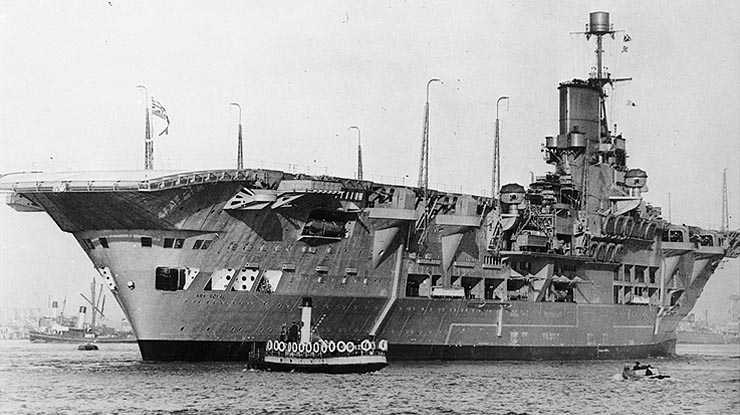
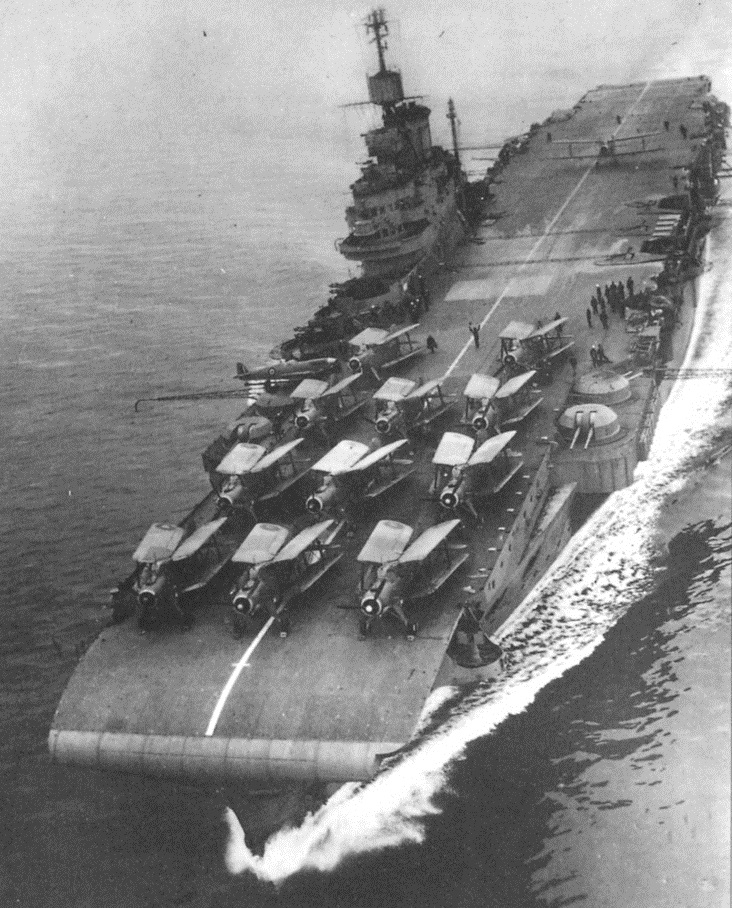
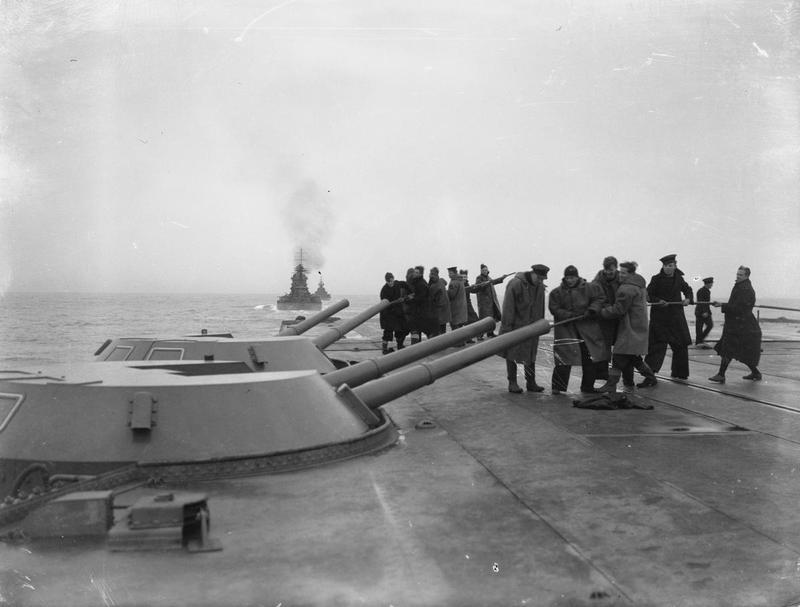
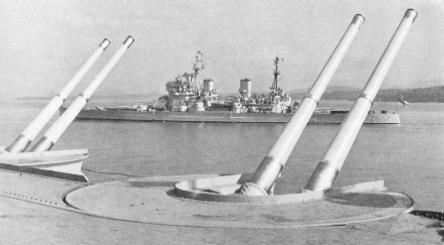
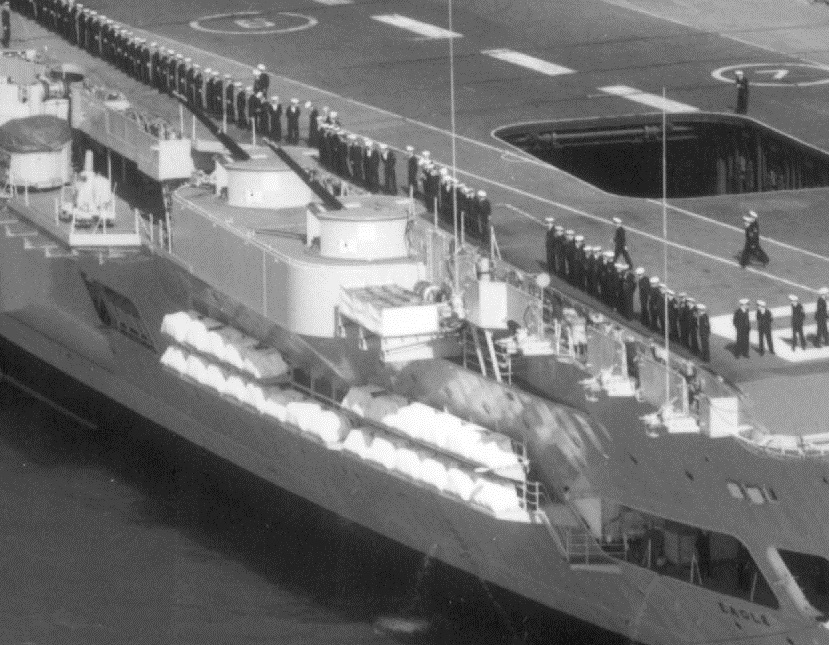
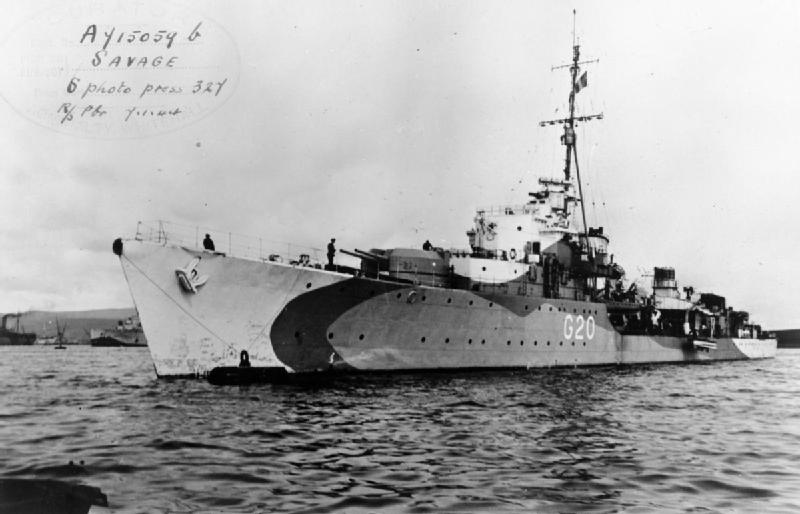
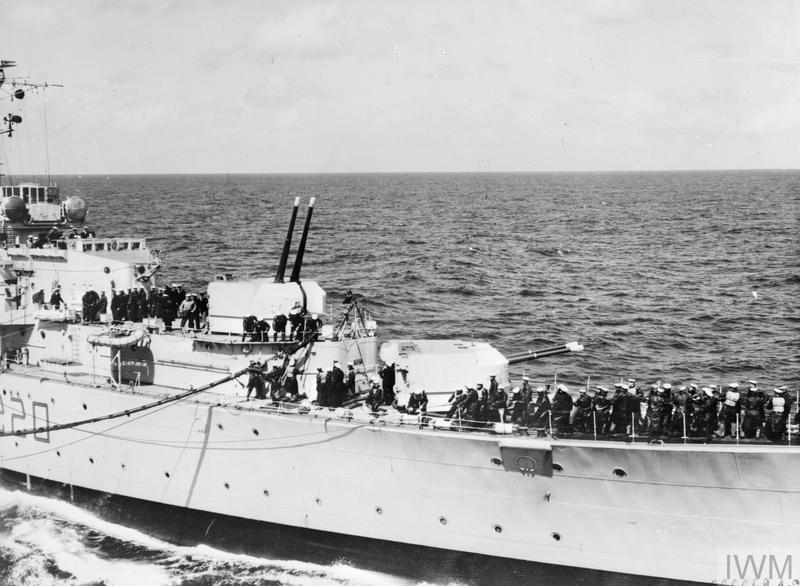
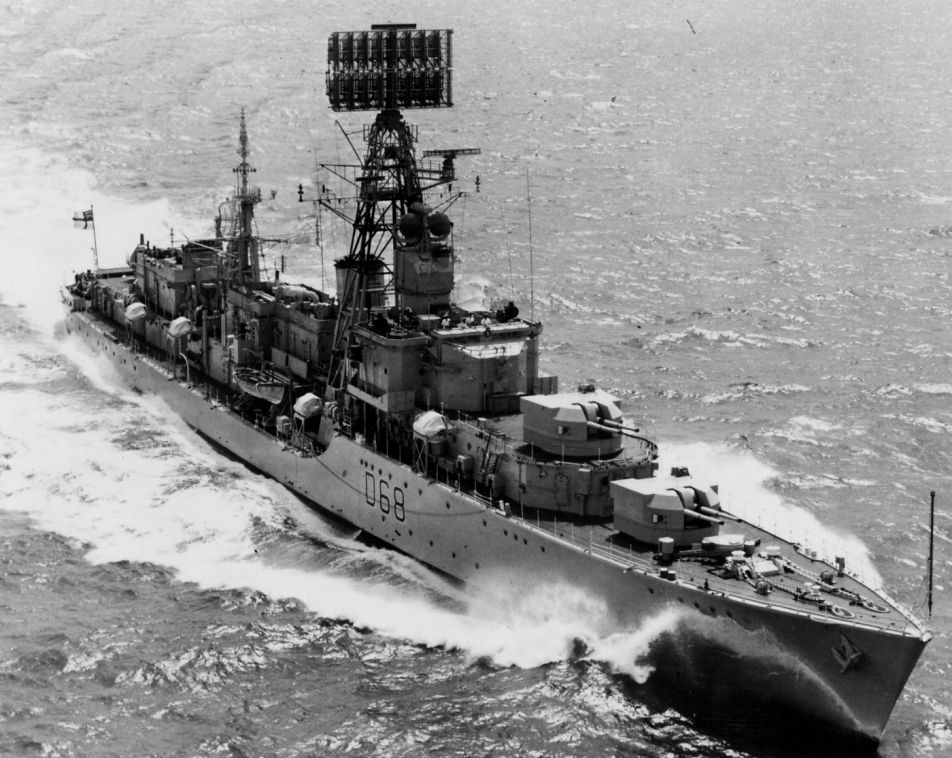
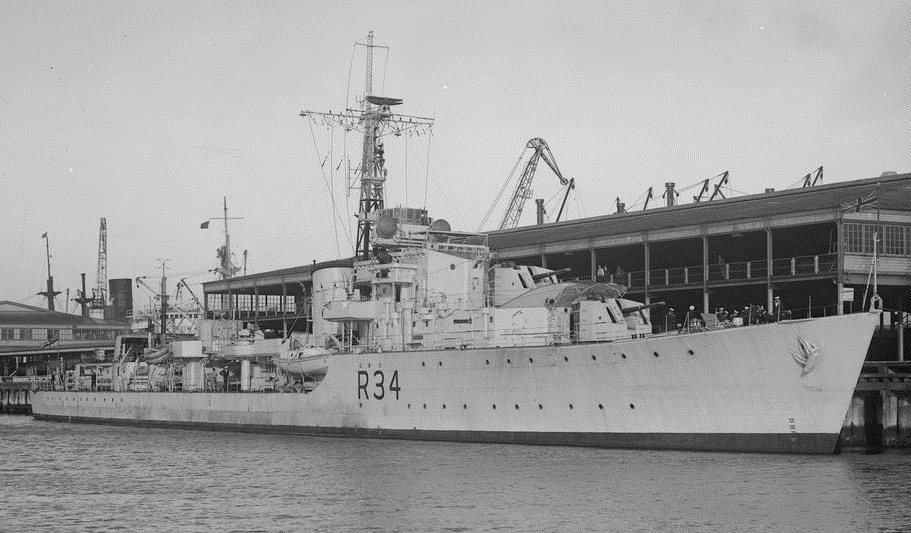
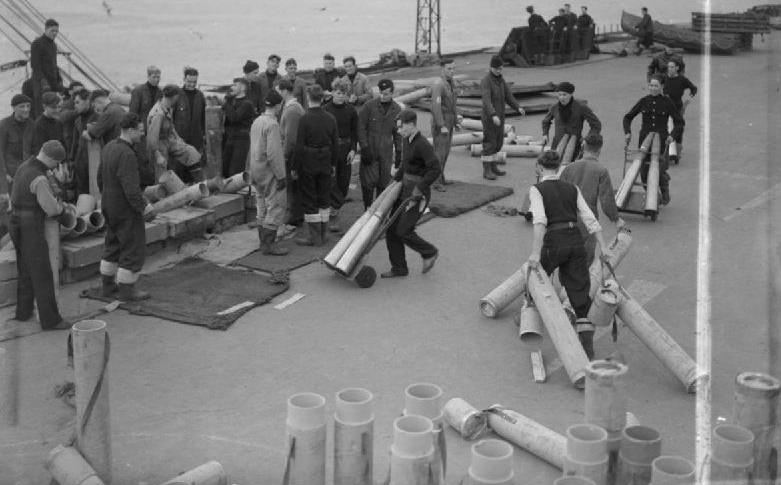
Images at The Vickers Photographic Archive
For Mark II Mounting (Capital Ships and
Carriers): Deck Mark II
For Mark III Mounting (Carriers): Twin 4.5 HA LA
For Mark IV Mounting (Battle class): Mk IV Naval
For Mark V and RP50 Mark V Mountings (Z, Ca, Ch, Co and Cr classes): 4852,
7164,
7165,
7166
and 7167
For Venezuelan Nueva Esparta: Mounting swung crane,
0714
and Twin mounted Esparta
For Venezuelan Zulia: 0726
and 2241
"Nelson to Vanguard: Warship Design and Development 1923-1945" and "The Design and Construction of British Warships 1939-1945: Volume I" both by D.K. Brown
"Naval Weapons of World War Two" by John Campbell
"The Naval Institute Guide to World Naval Weapon Systems 1991/92" and "British Carrier Aviation" both by Norman Friedman
"British Aircraft Carriers: Design, Development and Service Histories" by David Hobbs
"Leander Class Frigate Conversions" article by Peter Hodges in "Warship Volume III"
"Destroyer Weapons of World War 2" by Peter Hodges and Norman Friedman
"Warships of World War II" by H.T. Lenton and J.J. Colledge
"British Battleships of World War Two" and "British Cruisers of World War Two" both by Alan Raven and John Roberts
"The Battle-cruiser HMS Renown 1916 - 1948" by Peter C. Smith
"Destroyers of World War Two" by M.J. Whitley
---
H.M.S. Solebay Association
---
Special help from Anthony G. Williams
29 May 2007 - Benchmark
12 January 2009 - Added cartridge information, added additional information on the Mark II and Mark IV mounts
01 June 2009 - Added ammunition information for Queen Elizabeth, Valiant and Renown, added additional information on
shell handling and supply to mounting notes, added note concerning accident to Renown, added picture of mountings on Renown
15 December 2011 - Changed picture from HMS Barfleur to HMS Barrosa
12 February 2012 - Updated to latest template
19 June 2012 - Added mounting information
11 January 2014 - Added photograph of HMS Illustrious and redid photograph of HMS Indomitable
24 May 2014 - Added photograph of HMS Savage
06 October 2014 - Minor changes
01 December 2015 - Changed Vickers Photographic Archive links to point at Wayback Archive
11 January 2016 - Added information about HMS Ark Royal (1955) and HMS Eagle (1951) mountings and added photograph of HMS Victorious
04 March 2016 - Added photograph of HMS Eagle
07 September 2016 - Converted to HTML 5 format
29 March 2019 - Reorganized notes, added photograph of HMS Finisterre
14 August 2019 - Added notes to clarify fixed and separate ammunition mountings, changed link to HMS Solebay Association to point at
Wayback Archive, added comments about breech mechanism in QF and SA modes
03 November 2021 - Minor changes in ammunition section
16 March 2022 - Corrected formatting issues
26 February 2025 - Corrected typographical error
